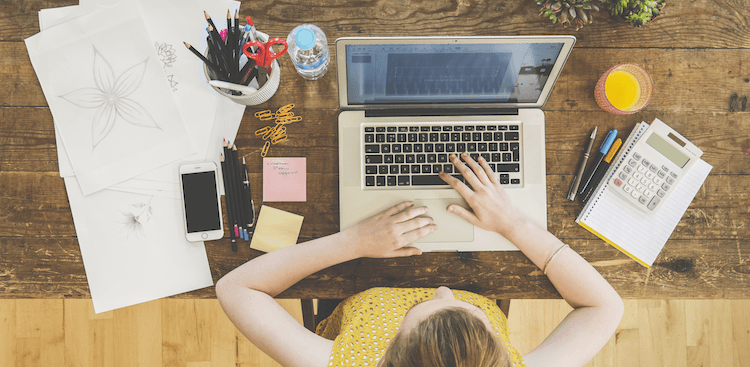Six years ago I left my cubicle to work from home and for the first few days (OK, maybe weeks), I walked aimlessly from room to room, cruised the fridge for mini Babybels, and tried a home work setup at the kitchen table, on the sofa—even propped up in bed with 13 pillows. And with NYC sirens as my constant playlist, I even took important phone calls and podcast interviews in my closet.
I couldn’t quite figure out where to work or when to focus on which tasks throughout the day. It’s not always easy to create your own work schedule for the week or even to know how best to break up and plan out each day.
The good news: Working from home has no hard and fast rules.
The bad news: Working from home has no hard and fast rules.
What six years at home has taught me is this: You should make a plan and keep it simple. Having a general guide for what you’re supposed to tackle at what time will help you structure your day and get things done. A productivity plan, as I like to call it, keeps you on track so you don’t just look at your watch at 4:13 PM and think, “Where did today go?”
At a time when so many people are working from home for the first time due to the coronavirus pandemic, you might be finding yourself in need of a productivity plan of your own. Here’s a helpful, loose daily structure I’ve come to rely on along with some tips to help you adapt it for your own needs. With a few adjustments—according to when you wake up, when you’re expected to be reachable, what time of day you focus best, and, of course, whether you have kids or other caregiving responsibilities—you can make it work for you.
So pick and choose the blocks that make sense in your life, shuffle them around in the order that feels right, and give your plan a try.
7:30 AM
Wake up!
7:45 AM
Kick off that morning routine: Take a shower, drink coffee, meditate, stretch, check your most important apps (Gmail, Slack, whatever they are for you) to see if there’s anything you need to address first thing.
Don’t skip the routine, however short. The first hour of the day sets the tone for the rest of it so news plus Instagram probably isn’t your best bet—don’t let yourself get lost in a social media scroll hole or watching CNN before you’ve had a chance to do anything else!
And put on some comfy, clean clothes. In my experience, it makes a difference to your mood. Being in your PJs, sweatpants, or oversized T-shirt is OK once in a while. But in general, I’d suggest changing into a work outfit, even if it’s not quite the same as what you’d wear to an actual office. How we dress affects our performance. It also doesn’t hurt to be Zoom ready!
8:15 AM
Handle anything urgent and give any updates to your boss and teammates. Getting this done first thing will give you peace of mind to dive into your work and focus without the nagging feeling that you’ve forgotten something or that someone’s waiting on you. (It also lets your boss know you’re awake and crankin’!)
8:45 AM
Get crackin’! Do your most important and creative work first (caffeinated, if that’s your style). Use that golden morning brain to focus on something bigger than busywork. If you spend the first 90 minutes or so of your day chipping away at an important task or project, then no matter what—even if the rest of your day gets thrown off by something urgent (work crisis, partner problems, roommate issues, kid interruptions)—you’ll feel satisfied that you accomplished something meaningful.
10 AM
Coffee or tea break! After 75 minutes or so of focus, you’ve earned it. Check in with a loved one or two via text. Social distancing is not emotional distancing! This is also a fair, decent time to do a social media check in (with a tight limit).
10:15 AM
Back to that important and creative work—hopefully a little refreshed. It helps to set aside solid chunks of time on your calendar to focus on priority projects. I’ve learned the hard way that if you don’t, it’s easy to end up being reactive to other people’s requests and see an entire day get frittered away. Being self-directed matters. You set the flow, you don’t just go with it.
12:30PM
Lunch! Leave your workspace if you can for a change of scenery and so that you can actually enjoy your food. You don’t want to suddenly look down to see an empty plate and realize you didn’t even taste your tuna melt because you were still typing. Move your body a little if possible, too, and try to get outside for a bit if you can. (These things can help you recharge and deal with anxiety you might be experiencing during this pandemic.)
1:30 PM
Time for correspondence! Like set blocks devoted to creative and focused work, designated email time is incredibly helpful. Otherwise your inbox can take over and suck up the entire day. Most people waste their best morning brain replying to emails and doing follow ups but not you, clever one! Look what you’ve already achieved in the morning with that fine focus of yours!
So now’s the time to reply to all nonurgent emails and messages. Remember, not every note requires your immediate attention. Most emails can be answered respectfully within 24 hours.
2:30PM
If you can swing scheduling it this way, early afternoon is a superb time for virtual meetings! Extroverts, you’ll get a good boost from seeing your colleagues, and introverts, you’ll already have had most of the workday to yourself so you’ll probably be feeling nice and recharged from yesterday’s meetings and chatter.
4:30 PM
Back to emails and other correspondence one more time before the end of the day—it never ends, I know!
5 PM
Wrap up and plan for the next day. Before you completely sign off, jot down your top three priorities for the following morning. This will keep you centered on what matters most (and help you know how to kick off the next day with your best brain). I admit I even feel a bit of exhilaration knowing what I’ll be opening my laptop to work on when I wake up!
5:30 or 6 PM
Mix yourself a martini, have a video chat or two with friends and family, plan and dig into dinner, watch Tiger King on Netflix (mandatory), or do whatever else you’d look forward to after a day of work. It’s great to have specific fun activities planned for some of your evenings to punctuate the end of the workday—and force you to step away and slip into chill mode.
You have so much power when it comes to designing your day. Having even a rough outline like this to guide you will help you enjoy working from home more, help you get way more done, and make this social distancing situation more tenable. It may be a temporary situation but that doesn’t mean you have to write off regular, helpful routines—just that you need to find one that works for this moment.
The most important thing to keep in mind is that social distancing won’t last forever. And even amid the chaos of our current crisis, you can create order of your own.

